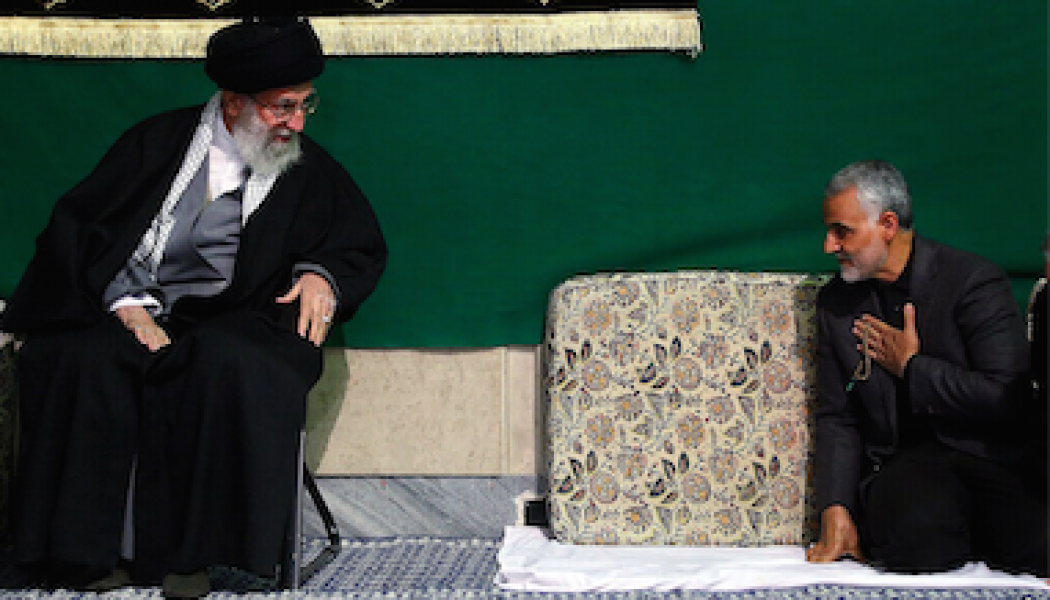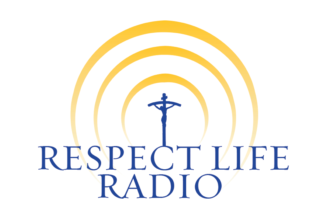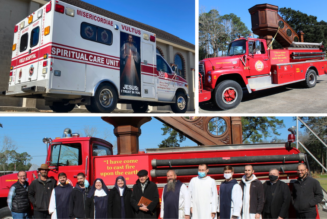
> Italiano
> English
> Español
> Français
> All the articles of Settimo Cielo in English
*
Six days after the killing in Baghdad of Iranian general Qassem Suleimani (in the photo, with Ayatollah Ali Khamenei), there was great anticipation over what Francis would say in the traditional beginning of the year speech to the diplomatic corps.
The pope expressed himself in this regard with these words, revisiting what he said before at the Angelus of January 5:
“Particularly troubling are the signals coming from the entire region [of the Middle East] following the heightening of tensions between Iran and the United States, which risk above all compromising the gradual process of rebuilding in Iraq, as well as setting the groundwork for a vaster conflict that all of us would want to avert. I therefore renew my appeal that all the interested parties avoid an escalation of the conflict and ‘keep alive the flame of dialogue and self-restraint,’ in full respect of international law.”
It should be noted that there is a long-standing rapport between the Holy See and Iran. Diplomatic relations have existed since 1954, and also with Shiite Islam and its ayatollahs there is a more consolidated tradition of cultural exchange than with Sunni Islam. On the geopolitical terrain, Vatican diplomacy has generally seen in Iran a factor of stabilization rather than of confrontation, as well as of the protection of Christian minorities in Iran itself and in neighboring Syria. During the Syrian conflict still underway, the Holy See has always sided with Bashar el Assad’s remaining in power, in fact mainly insured by Suleimani’s al Quds militias, ruthless with civilian populations no less than with combatants.
*
Recently, however, at the Vatican there have been some signals of a critical stepping back from this traditional good neighbor policy with the Islamic Republic of Iran.
The issue of “La Civiltà Cattolica” sent to press a few hours before the killing of Suleimani is an interesting “test” of how the Vatican now looks at Iran’s ambitions for hegemony over Lebanon and Iraq, as well as over Syria.
Giovanni Sale – the Jesuit who deals with the Muslim world in the magazine directed by Father Antonio Spadaro and published after undergoing “inspection” by the pope – dedicates ten pages to the popular revolts that have been roiling Lebanon, Iraq and Iran for several months.
And as for Iraq, Father Sale writes that the main targets of the protests driven by the young are precisely “the ayatollahs of Tehran, very much interested in strategically controlling the region of the so-called ‘Shiite crescent’.”
In Iraq – the Jesuit explains – there is currently “an unofficial quota system,” which “divides power among the first three groups of voters: the Shiites, the Sunnis, and the Kurds,” assigning preeminence to the first, with support from Iran, including military support.
And this military support swung right into action at the beginning of the popular revolt against Iranian supremacy. Father Sale writes:
“Since the protest broke out on October 1, 2019, according to official estimates the number of deaths has been around 360, while that of the injured has been 16,000. During the first week of the uprising there were unidentified snipers attributed to Iran who fired on the crowd. The riot police of Brigade 46, in charge of the security of the ultra-protected ‘green zone,’ where the government resides, also actively participated in the repression, firing live ammunition.”
But in spite of this – the Jesuit continues – the protests also spread to Iran as of mid-November. And there too the repression has been bloody:
“Many demonstrators are protesting over the expensive foreign policy conducted by the Islamic Republic in support of its allies and regional clients: the Hezbollah in Lebanon, the Huthi in Yemen, the Syrian government and the numerous Iraqi Shiite militias. […] The demonstrations have been severely repressed by the police, who have not hesitated to use, as in Iraq, live ammunition against the demonstrators, causing, according to Amnesty International, at least 208 deaths. […] The uprisings have however continued, in part because the social discontent that is shaking the country is not only economic, but deeper. What is being contested is the exportation of the Islamic revolution which legitimizes the regime and spends public money on distant wars, depriving its citizens of basic services.”
Father Sale writes in conclusion of his analysis:
“The propaganda of the regime immediately interpreted the facts according to the usual clichés: the street uprisings were manipulated by the enemies of the Islamic revolution. […] But even if the protests in Iran, Iraq and Lebanon were somehow quelled, the problem for Tehran would remain. It is not only the Americans, Israelis, or Saudis who want to contain Shiite influence in the region and to badger the rulers of the Islamic Republic. The pressure is also coming from the impoverished and disillusioned communities of the Middle East, for which the old slogans on resistance against the ‘external enemies’ of the Shiite revolution are no longer sufficient and not even necessary.”
*
That’s all in terms of what “La Civiltà Cattolica” writes. But there is also the unsaid, what the Vatican knows but prefers to keep silent. And among the unsaid there is the role played for many years by General Suleimani, before a missile launched from an American drone annihilated him just outside the Baghdad airport, on the night between January 2 and 3.
When Father Sale mentions the “unidentified snipers attributed to Iran” who fired on the demonstrators in Baghdad, he does not make it clear that at the beginning of the protest, when the Iraqi security forces met with Prime Minister Adil Abdul Mahdi, a Shiite, to decide how to repress it, in charge of the meeting was Suleimani himself, as reported by a detailed correspondence from the Associated Press. And the next day the snipers started firing from the rooftops.
In providing the numbers of the victims in Baghdad “La Civiltà Cattolica” follows the “official estimates.” But in three months of demonstrations, the dead and injured appear to have been many more, respectively 600 and 22,000, according to what was reported to “Corriere della Sera” of January 8 by Ahmed al Mutlak, member of parliament and secretary general of the Sunni Iraqi party named Negotiation and Change.
Suleimani is also implicated in the disappearance of 12,000 Sunni Iraqis captured as suspected members of the opposition while fleeing south from the regions occupied and then lost by ISIS.
In Iraq, the Shiite militias commanded directly or indirectly by Suleimani number over 140,000 combatants, largely infiltrated by Iran, and intersect with the official military corps. For example, as Ahmed al Mutlak goes on to say to “Corriere,” the military head of Ashad al Shaabi, or Shiite Popular Forces of Mobilization, is the same Faleh al Fayaz who commands the Iraqi military intelligence service, and whose second in command was that Abu Mahdi al Muhandis who was killed along with Suleimani in the vehicle hit with the American missile. Al Muhandis was also the leader of the Kataib Hezbollah, the Battalions of the Party of God, the Shiite militia that directed the assault against the American embassy in Baghdad in late December and that in mid-December had massacred dozens of peaceful demonstrators in the Baghdad garage where they were spending the night, according to witnesses interviewed by “il Foglio” correspondent Daniele Raineri.
Suleimani was the all-powerful strategist at the head of the al Quds militia of the Guardians of the Revolution, the elite force of the army of the Islamic Republic of Iran in charge of carrying out covert operations abroad.
The war in Syria in support of Assad’s pro-Iranian regime had been his biggest exercise. In 2015 it was Suleimani who persuaded Putin to intervene with Russian bomber planes, while he provided for the battle on the ground, sending into combat hundreds of Shiite mercenaries recruited in Afghanistan, Pakistan, Iraq and only to a limited extent in Iran. To capture a city district or a village Suleimani practiced a wholesale war: not risky house-to-house combat, but siege. No more water, food, or medicine for the entire population, without distinguishing between fighters and civilians. With hundreds of thousands of victims. The survivors did not mourn his killing, a few days ago.
In Iran, in the sea of crowds for his funeral, not present were those who had demonstrated during the previous weeks precisely against that “exportation of the Islamic revolution” which was the main objective of Suleimani’s action.
Above all, not present were the families of the “at least 208 dead” who according to the Amnesty International tally reported by “La Civiltà Cattolica” were the ultimate price of that demand for freedom which Suleimani held so much in hatred.








